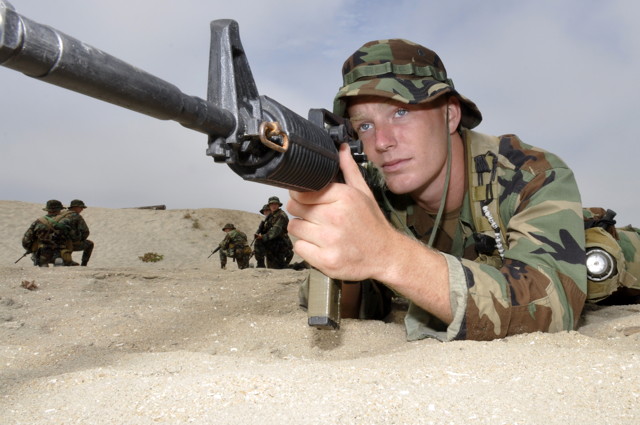Interview with Rick Kaiser, an ex-Navy SEAL who specialised in winter warfare, sniping and combat swimming. He was assigned to an Assault Squadron and was selected for the Enlisted Education Advancement Program (EEAP). He was presented with a Silver Star for Valor at the Battle of Mogadishu (aka Black Hawk Down) and has also tracked down war criminals in Bosnia and been deployed in Afghanistan. He retired from active duty in August 2000 after 22 years of service and currently acts as Executive Director of the Navy SEAL Museum.
Why and when did you choose to join up?
I joined the Navy on Sept 1979 after reading a pamphlet in the recruiters’ office about Nay SEALs called “Men with Green Faces”. I had no idea what I was getting into but I thought it looked like fun.
How long were you with each part of the force for?
SEAL Team 2 (ST-2) 1980-85 Naval Special Warfare Development Group (NSWDG) 1985-2012
Describe the whole training procedure to us
BUD/S Basic Underwater Demolition SEAL training is six months long and was held in Coronado CA. It was divided into three sections. 1. Basic Conditioning / Hell Week 2. Dive Training 3. Land Warfare. I graduated class 109
What was the most difficult part of training and why?
The worst part of training was the daily grind. Knowing you would have to get up each day and be challenged both mentally and physically, no excuses, just you and the instructors.
Were you prepared or was it a step up to what you expected?
No one is prepared for BUD/S.
Is it more physically difficult or mentally strenuous? Why?
50/50. The daily grind was mentally tough each day but none of your mental toughness counted in the end if you could not perform the myriad of physical activities that were planned each day. The mental part came at night or while eating a meal. Knowing what was coming next was sometimes as hard to deal with.
Were there any times you wanted out?
Once, on the third day of hell week. With no sleep and at the midnight meal (you ate 4 times a day to keep your energy up) I finally felt warm, somewhat dry and relaxed. I started feeling sorry for myself and thinking about quitting. The instructors, thank God, saw the class falling asleep and put us all in the cold water for an extended period of time and I snapped out of it.
Did you witness anyone ‘ringing the bell’ and not making the grade during training?
Yes, I saw many people quit. Approx. 70% of all BUD/S students drop out. It has been the same since WWII to today.
What is the toughest of all the phases? Can you describe exactly why this exercise was tougher than all the rest?
The initial training and conditioning of the first phase was the toughest for me. The instructors really tried to weed out the weak. In their words “I would rather have you quit here in training than in combat”.
How did you adjust to the lack of sleep?
I was young. You go into automatic mode. The hard part is to pay attention to detail.
Did anyone in your group achieve the ‘Honor of Man’ class? How were they different from the rest of the candidates?
Yes his name was Brad Young. He was later fired for stealing a camera from the Danish Frogmen. No different than anyone else except better scores on runs, swims and perhaps liked more by the instructors.
How was SEAL Qualification Training different to BUD/S?
BUD/S is basic training. SQT is advanced training.
What was your specialist role(s) within the SEALS? Combat Swimmer, Lead Diver, Breacher, Sniper, Sniper Instructor, Training Chief, Operations Officer and Military Free Fall instructor.
What and where was your first assignment?
ST-2 Little Creek Virginia, Virginia Beach Feb 1980
Did you have a rapport with you squad or was it quite an isolated place?
Rapport with the older guys came with time and trust. A few of my BUD/S classmates also went to ST-2 initially so we hung together.
How has the force changed since you began? SEALs today must be much more technology savvy individuals. Gone are the days of the sniper pair going in to make the one shot. Now a good SEAL on a radio or computer can do so much more.
What was your toughest mission? Training missions are always tougher than the real thing. Practice for a particular operation usually meant much more pain than the real thing.
What weaponry did you use?
Primary weapon was a M4 or HHK 416 and Secondary was a Sig Sauer P226. Sniper rifle was a 300 Winchester Magnum.
What was your relationship like with other special forces from the UK, allied countries and enemy countries? Did you come into contact with them much?
I had the pleasure of serving with both the SBS and the SAS. SEALs are naturally closer to the SBS than the SAS due to our water backgrounds. I have many friends in both services and have had many a beer at the pub.
Where were you posted around the world?
Virginia Beach Virginia, Machrihanish Scotland, Stuttgart Germany, Mogadishu Somalia, Bagram AFB Afghanistan, Coronado CA, Sarajevo Bosnia, Bergen Norway, Thule Greenland, etc.
Did you ever have any allies killed in action?
Many
What have you taken away from the experience?
Trust no one but your teammates and families. Don’t fight thinking there is some kind of moral purpose or high ground because history has a way of changing or at least becomes clearer as time goes on.





